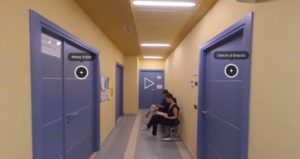
- Development of socio-cultural competence: uses and customs of the hosting country
- Development of linguistic competence: vocabulary and structures related to the topic covered in the video
At the end of the Learning Unit, the learners will know the lexicon and the structures related to the situation represented in the video and will be able to use them by interacting adequately with a native speaker both in the context represented and in similar contexts.
- Watching the video should help students to lower the emotional filter if in the future they find themselves in a situation in which they have to relate to authority be it a doctor, a bank official, a teacher.
VR Video A downloaded on all mobile media (smartphone)
cell phones, VR glasses, earphones
downloadable attachments, photocopies
The vision of video A is to be considered as a starting point for the development of the language lesson that will be built around it. Watching video A allows the teacher to work with learners at different levels:
• Emotional: the learner finds himself immersed in a semi-real situation and this allows him/her to connect life experiences to actual linguistic uses; total immersion facilitates both understanding and memorization of linguistic structures.
• Behavioral: the immersive vision of the video allows to deal with particular aspects of the behaviour linked to the uses and customs of the welcoming country.
• Linguistic: each video is designed to address a specific real situation by introducing its lexicon and related linguistic structures.
Introductory phase
A phase of the approach to the text and the situation represented in the video is necessary to make the content accessible for learners with very limited linguistic competence.
The function of the introductory phase is to activate mental processes to promote learning: intrigue the student and activate his general knowledge (knowledge of the world) and linguistic-communicative ones.
| Reference | Description | File |
|---|---|---|
| 1.1, 1.2, 1.3 | Exercises to be completed in this first phase: |
Central phase
The vision of the VR video (distribution to the students of the viewers with embedded cellphones already set to watch the video, start the video simultaneously for everyone or, if there are not enough viewers for all the
participants, the class is divided into small groups) combined with an understanding activity (see e.g. 2.1).
After watching the video, activities are proposed that will allow learners to focus attention on the lexicon and relevant structures in the text and to reuse what has been presented and acquired.
| Reference | Description | File |
|---|---|---|
| 2.1, 2.2, 2.3, 2.4, 2.5 | Exercises to be completed in this second phase: |
Final phase
In the last phase, an activity is proposed to summarize the vocabulary and expressions acquired.
The model can be adapted to the different situations represented in the videos and to the lexical content.
| Reference | Description | File |
|---|---|---|
| 3.1 | Exercise to be completed in this third phase |